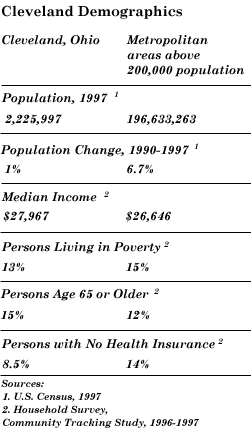
Local Organizations Retain Market Dominance:
Cleveland, Ohio
Community Report No. 02
Fall 1998
Claudia Williams, Jon B. Christianson, Christina A. Andrews, Raymond J. Baxter
![]() n June 1998, a team of researchers visited Cleveland, Ohio, to study that
community’s health system, how it is changing and the impact of those changes on
consumers. More than 50 leaders in the health care market were interviewed as part
of the Community Tracking Study by Health System Change (HSC) and The Lewin Group.
Cleveland is one of 12 communities tracked by HSC every two years through site visits
and surveys. Individual community reports are published for each round of site visits.
The first site visit to Cleveland, in June 1996, provided baseline information against
which changes are being tracked. The Cleveland market includes the city of Cleveland and
its suburbs.
n June 1998, a team of researchers visited Cleveland, Ohio, to study that
community’s health system, how it is changing and the impact of those changes on
consumers. More than 50 leaders in the health care market were interviewed as part
of the Community Tracking Study by Health System Change (HSC) and The Lewin Group.
Cleveland is one of 12 communities tracked by HSC every two years through site visits
and surveys. Individual community reports are published for each round of site visits.
The first site visit to Cleveland, in June 1996, provided baseline information against
which changes are being tracked. The Cleveland market includes the city of Cleveland and
its suburbs.
![]() n 1996, the Cleveland market appeared to be
in turmoil. The community had experienced or was anticipating a number of high-profile
mergers. Historic collaboration among providers had given way to competition, sparked by
the market entry of two for-profit hospital systems. Local providers and plans, it seemed,
were threatened. Yet, change in Cleveland did not materialize as expected. The proposed
merger between Blue Cross and Blue Shield of Ohio and Columbia/HCA disintegrated. The three
large local, not-for-profit institutions - The Cleveland Clinic, University Hospitals Health
System (UHHS) and Medical Mutual of Ohio, the former Blue Cross and Blue Shield
Plan - remain dominant.
n 1996, the Cleveland market appeared to be
in turmoil. The community had experienced or was anticipating a number of high-profile
mergers. Historic collaboration among providers had given way to competition, sparked by
the market entry of two for-profit hospital systems. Local providers and plans, it seemed,
were threatened. Yet, change in Cleveland did not materialize as expected. The proposed
merger between Blue Cross and Blue Shield of Ohio and Columbia/HCA disintegrated. The three
large local, not-for-profit institutions - The Cleveland Clinic, University Hospitals Health
System (UHHS) and Medical Mutual of Ohio, the former Blue Cross and Blue Shield
Plan - remain dominant.
After an active period of deal making, focus now seems to have shifted to internal organizational issues. Key changes shaping the health system today include the following:
- Market concentration is increasing in the hospital sector.
- Hospitals are expanding high-end medical services.
- Plans are facing stiff price competition and internal administrative difficulties.
- Employers are not pursuing aggressive purchasing strategies.
- Threat to Local Entities Subsides
- Market Concentration Increasing
- Mergers Spur Expansion of High-End Medical Services
- Plans Face Stiff Price Competition
- Purchasers Seem Content with Status Quo
- Medicaid Plans Face Low Rates and Declining Rolls
- Issues to Track
- Cleveland Compared to Other Communities HSC Tracks
- Background and Observations
Threat to Local Entities Subsides
![]() leveland remains a community where
leaders in business circles and local provider organizations are closely aligned through
membership on the same community boards. These relationships are important forces shaping
the direction of health system change in this market. Since HSC’s 1996 site visit, three
local institutions - the Cleveland Clinic, UHHS and the former Blues plan, Medical Mutual
of Ohio - have retained dominance in the market, while organizations without local roots
have lost market position.
leveland remains a community where
leaders in business circles and local provider organizations are closely aligned through
membership on the same community boards. These relationships are important forces shaping
the direction of health system change in this market. Since HSC’s 1996 site visit, three
local institutions - the Cleveland Clinic, UHHS and the former Blues plan, Medical Mutual
of Ohio - have retained dominance in the market, while organizations without local roots
have lost market position.
In the hospital sector, the market entry of two for-profit hospital chains - Columbia/HCA and Primary Health Systems (PHS)- prodded the two leading not-for-profit provider systems to increase their market share through acquisitions and affiliations. While competition in the hospital sector has intensified, several institutions continue to offer forums for collaboration, including Cleveland’s hospital association and Cleveland Health Quality Choice (CHQC), a communitywide quality initiative.
The anticipated merger between Blue Cross and Blue Shield of Ohio and Columbia/HCA was expected to have a profound impact on the market. However, the proposed merger fell apart in March 1997, the same month that the national Blue Cross and Blue Shield Association stripped the insurance plan of its Blues trademark. The former Blues plan, renamed Medical Mutual of Ohio, reported a $95 million loss for 1996. But, since 1997, Medical Mutual has rallied successfully, maintaining its market share, key partnerships and its position as the dominant local plan.
To do so, Medical Mutual reportedly has pursued an aggressive pricing policy. In addition, the plan has made changes in key leadership positions, promoting staff and hiring back former employees. Medical Mutual also has maintained its close relationship with the Chamber of Commerce’s small-business purchasing group and has successfully renegotiated its contract with the Cleveland Clinic. The plan’s ability to retain its market position during the last two years appears to be further evidence of the importance of relationships and local identity in the Cleveland health care market. Its success was enhanced by the fact that Anthem, the Indianapolis-based plan that acquired the Blues trademark in the market, has not increased its share as anticipated.
Market Concentration Increasing
![]() oth the Cleveland Clinic and
University Hospitals have extended their reach throughout northeastern Ohio. They
have developed additional primary and tertiary care capacity in partnership with
their owned and affiliated providers. While both systems have grown, the Cleveland
Clinic has clearly eclipsed its rival in market share. The Cleveland Clinic owns 40
percent of the hospital beds in Cuyahoga County and 30 percent in the broader six-county
Primary Metropolitan Statistical Area (PMSA), compared with UHHS’s 11 percent market share
in Cuyahoga County and in the PMSA.
oth the Cleveland Clinic and
University Hospitals have extended their reach throughout northeastern Ohio. They
have developed additional primary and tertiary care capacity in partnership with
their owned and affiliated providers. While both systems have grown, the Cleveland
Clinic has clearly eclipsed its rival in market share. The Cleveland Clinic owns 40
percent of the hospital beds in Cuyahoga County and 30 percent in the broader six-county
Primary Metropolitan Statistical Area (PMSA), compared with UHHS’s 11 percent market share
in Cuyahoga County and in the PMSA.
Since HSC’s 1996 site visit, the Cleveland Clinic merged with the four-hospital Meridia Health System and the two-hospital Fairview Health System. It has also acquired Health Hill Hospital, a pediatric facility. At the same time, the Cleveland Clinic continues to build its Cleveland Health Network (CHN), which includes nine owned and 16 affiliated hospitals brought together under a super physician-hospital organization (PHO). To date, CHN has reportedly negotiated 40 contracts with 20 payers.
Most physicians who are not affiliated with one of the major hospital systems in the market remain in small groups. These physicians seem anxious about their futures and apprehensive about the increasing consolidation and influence of the hospital sector. Yet, there is little evidence of physician efforts to organize separately from hospitals. There are a few independent physician organizations, including multispecialty group practices, but none is seen as a major market force organizing physicians. Change may be on the horizon, however. At least two physician practice management companies have entered the market and may serve as potential future organizers for physicians.
While the two local not-for-profit hospital systems have grown, the two for-profit systems - Caritas, the partnership of Columbia/HCA and Sisters of Charity, and PHS - have suffered a loss of market position in the last two years. Initially, Columbia/HCA attempted to develop a statewide provider presence just as the Cleveland Clinic and UHHS were expanding their influence in the local market. More recently, Columbia/HCA has been preoccupied with its national crisis and the failure of its planned merger with Blue Cross and Blue Shield of Ohio. Meanwhile, PHS has been distracted by the financially troubled Mount Sinai Medical Center. Saddled with a large debt, the system has struggled to retain patients, while a number of its physicians have moved to UHHS and other hospitals.
Despite some concerns voiced in 1996, however, there are no reports that these for-profit systems have reduced their charity care. Both systems serve large numbers of low-income patients, and, in spite of their difficulties, apparently have continued to provide charity care for these patients at a relatively constant level. At the same time, MetroHealth, Cuyahoga County’s public hospital, continues to be the leading provider of charity care and Medicaid services. The hospital maintains a close relationship with the Cleveland Clinic, participating as a lead member of CHN.
Mergers Spur Expansion of High-End Medical Services
![]() wo years ago, Cleveland was viewed as
a specialty-oriented health care market with considerable excess hospital capacity. This
is even more true today. Providers continue their efforts to attract patients by increasing
the availability of specialized services, with little observable effort to reduce costs and
achieve efficiencies. Furthermore, the expiration of Ohio’s certificate-of-need legislation
has opened the door for new construction and technology investments by hospitals.
wo years ago, Cleveland was viewed as
a specialty-oriented health care market with considerable excess hospital capacity. This
is even more true today. Providers continue their efforts to attract patients by increasing
the availability of specialized services, with little observable effort to reduce costs and
achieve efficiencies. Furthermore, the expiration of Ohio’s certificate-of-need legislation
has opened the door for new construction and technology investments by hospitals.
The Cleveland Clinic and UHHS are taking the lead in adding new services. The Cleveland Clinic is teaming up with Lake West Hospital to establish a heart clinic at Lake, and with Elyria Memorial Hospital for heart and urology services. According to some respondents, the Cleveland Clinic is also investing heavily in its pediatrics and oncology services, both long considered UHHS strengths. Meanwhile, UHHS is partnering with Southwest General Hospital to develop open heart surgery, pediatrics and cancer services, and with Lake Hospital for cancer services.
Providers, it seems, have felt little pressure to consolidate their services. Instead, hospital mergers appear to have propped up otherwise vulnerable hospitals and contributed to the expansion of highly specialized services. The major provider systems view their investments in tertiary care services at owned and partner hospitals as a way to establish loyalty and referral relationships. Some respondents, particularly those in outlying communities, are pleased that specialized services are now available locally. Other respondents question whether this trend is in Cleveland’s best interest. They are concerned that expansion of highly specialized services may, over time, spread experience too thinly, diminish quality and increase costs.
To date, the Cleveland Clinic and UHHS have not done much to integrate services across their facilities, although both have consolidated some administrative functions. The two multihospital systems have achieved powerful market positions by increasing their size. But facility integration is a difficult and contentious process that is more complicated than negotiating a merger or acquisition and is often delayed by "stand still" agreements written into merger contracts. In the case of the Cleveland Clinic, integration efforts highlight cultural differences between salaried multispecialty group practice physicians at the Cleveland Clinic and independent, entrepreneurial staff physicians at newly acquired hospitals.
Plans Face Stiff Price Competition
![]() here is clear price competition among
health plans, driven in part by Medical Mutual’s aggressive pricing to maintain market
share. Premium levels have been flat or have declined during the past year. Purchasers
reportedly are switching plans for lower prices less frequently because their current
plans are willing to lower premiums to hang onto their business. Statewide, plans had
small negative margins in 1997, according to the Ohio Association of Health Plans. In
Cleveland, several plans, including Kaiser Permanente, reported losses for the year.
Plans have reacted by changing executive leadership and shedding money-losing product
lines, including Medicaid. Kaiser Permanente of Ohio removed its top Cleveland executives,
merged its Cleveland and Akron operations and tried to raise premiums by 9 percent after
posting a $36 million loss in 1997. Because of purchaser opposition, the actual premium
increase was much lower. Kaiser continued to lose market share as employers turned away
from traditional staff-model HMO products.
here is clear price competition among
health plans, driven in part by Medical Mutual’s aggressive pricing to maintain market
share. Premium levels have been flat or have declined during the past year. Purchasers
reportedly are switching plans for lower prices less frequently because their current
plans are willing to lower premiums to hang onto their business. Statewide, plans had
small negative margins in 1997, according to the Ohio Association of Health Plans. In
Cleveland, several plans, including Kaiser Permanente, reported losses for the year.
Plans have reacted by changing executive leadership and shedding money-losing product
lines, including Medicaid. Kaiser Permanente of Ohio removed its top Cleveland executives,
merged its Cleveland and Akron operations and tried to raise premiums by 9 percent after
posting a $36 million loss in 1997. Because of purchaser opposition, the actual premium
increase was much lower. Kaiser continued to lose market share as employers turned away
from traditional staff-model HMO products.
The relative stability of premiums may not be sustainable, and, in keeping with national trends, some predict an upturn for 1999. In Cleveland, health plans are trying to shift the focus of competition away from price to areas such as customer service and medical management. However, plans remain highly undifferentiated in the eyes of purchasers. Most plans share the same broad provider networks and are experiencing similar administrative problems.
For example, several respondents report that plans are having difficulty paying providers in a timely manner, in part due to implementation of new information systems. Others note that plans’ patient information is often inaccurate, requiring providers to establish parallel information systems to manage patient care and insurance coverage.
Purchasers Seem Content with Status Quo
![]() n contrast to some respondents’
expectations, purchasers have not increased their demands for highly managed insurance
products or turned to direct contracting to exert more control over cost and quality.
Perhaps this is because purchasers are already getting what they want: low premium
increases and very broad networks. In 1996, some observers thought that enrollment
increases in Medicaid and Medicare managed care might stimulate an overall increase
in managed care for the Cleveland market. Managed care penetration in both Medicaid
and Medicare has indeed increased. Medicaid managed care enrollment in Cuyahoga County
has risen from 54 percent to 88 percent of beneficiaries since 1996, while Medicare
managed care penetration has increased from 8 percent to 21 percent. However, overall
managed care penetration is only 27 percent. This rate is low compared with other
markets and has not increased much, presumably because of the commercial sector’s
slow conversion to managed care.
n contrast to some respondents’
expectations, purchasers have not increased their demands for highly managed insurance
products or turned to direct contracting to exert more control over cost and quality.
Perhaps this is because purchasers are already getting what they want: low premium
increases and very broad networks. In 1996, some observers thought that enrollment
increases in Medicaid and Medicare managed care might stimulate an overall increase
in managed care for the Cleveland market. Managed care penetration in both Medicaid
and Medicare has indeed increased. Medicaid managed care enrollment in Cuyahoga County
has risen from 54 percent to 88 percent of beneficiaries since 1996, while Medicare
managed care penetration has increased from 8 percent to 21 percent. However, overall
managed care penetration is only 27 percent. This rate is low compared with other
markets and has not increased much, presumably because of the commercial sector’s
slow conversion to managed care.
Purchasers have not stepped up their efforts to pursue direct contracting, although the Health Action Council (HAC) of Ohio, a coalition of more than 90 corporate members representing about 325,000 covered lives, has moved forward with its planned Centers of Excellence initiative. The HAC negotiated global fees for 22 procedures and conditions with five hospitals. Based on data from CHQC and other sources, HAC preselected certain area hospitals to apply for a Center of Excellence designation.
Some community hospitals complained that this process was unfairly biased in favor of large academic hospitals. Five individual hospitals, including the Cleveland Clinic and University Hospital, eventually were selected for participation. So far, the initiative seems to have had little effect on local purchasing; only a handful of employers have signed on to purchase services through the program.
Medicaid Plans Face Low Rates and Declining Rolls
![]() hio is moving ahead with mandatory
managed care for most Medicaid enrollees in several parts of the state, including
Cleveland. However, health plans report that it is increasingly difficult for them
to break even, let alone make a profit, in the Medicaid market. Since 1996, Ohio has
reduced its reimbursement rates for Medicaid managed care plans, while the number of
plans has increased. Mirroring national trends, the numbers of Medicaid beneficiaries
have fallen, probably reflecting the impact of welfare reform and a thriving economy.
hio is moving ahead with mandatory
managed care for most Medicaid enrollees in several parts of the state, including
Cleveland. However, health plans report that it is increasingly difficult for them
to break even, let alone make a profit, in the Medicaid market. Since 1996, Ohio has
reduced its reimbursement rates for Medicaid managed care plans, while the number of
plans has increased. Mirroring national trends, the numbers of Medicaid beneficiaries
have fallen, probably reflecting the impact of welfare reform and a thriving economy.
Several Medicaid plans are having financial difficulties, and some, including United HealthCare, have recently withdrawn from the Medicaid market. Two of the remaining plans, both locally managed insurers serving mostly Medicaid eligibles, reportedly are faltering as well. According to the Cleveland Plain Dealer, the 35,000 Medicaid enrollees in one of these plans, Personal Physician Care, will be disenrolled by the state, apparently in anticipation of the plan’s liquidation.
Respondents differed in their assessment of why Medicaid plans are having financial difficulties. Some cited the decline in the state’s payment rates and increased competition among plans. Other observers believe that the rates are adequate and claim that inadequate management systems and poor infrastructure are to blame for plans’ losses.
The number of Medicaid plans is expected to decline further as the state implements enrollment floors in each county. Under these new rules, only plans that enroll 10 percent or more of the eligible population will be allowed to contract with Medicaid. Disruption in health care services for Medicaid enrollees is not anticipated as a result of these changes. Most plans that contract with Medicaid to serve beneficiaries in Cleveland appear to include the same set of high-volume Medicaid providers in their networks.
Issues to Track
![]() uring the past two years, a small
number of local institutions have increased their influence in the Cleveland market.
The troubles of Columbia/HCA and PHS, coupled with the failure of the proposed merger
between Blue Cross and Blue Shield of Ohio and Columbia/HCA, created an opportunity for
local not-for-profit systems to strengthen their market positions. They have moved
aggressively to do so. As market developments continue to unfold, several key issues
bear watching:
uring the past two years, a small
number of local institutions have increased their influence in the Cleveland market.
The troubles of Columbia/HCA and PHS, coupled with the failure of the proposed merger
between Blue Cross and Blue Shield of Ohio and Columbia/HCA, created an opportunity for
local not-for-profit systems to strengthen their market positions. They have moved
aggressively to do so. As market developments continue to unfold, several key issues
bear watching:
- Will local organizations continue to dominate the market?
- Will provider concentration ultimately increase service integration? Will concentration generate regulatory attention?
- How will specialty service expansions affect the market?
- Will health care premiums remain relatively stable? If not, how will purchasers react? How might plans differentiate themselves from one another?
- How will instability in the Medicaid market affect care for the poor?
Cleveland Compared to Other Communities HSC Tracks
Cleveland, the highest and lowest HSC study sites and metropolitan areas with over 200,000 population
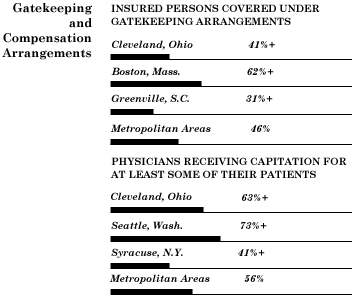
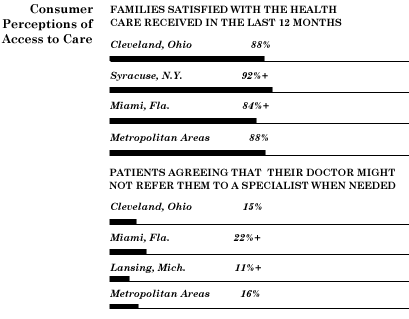
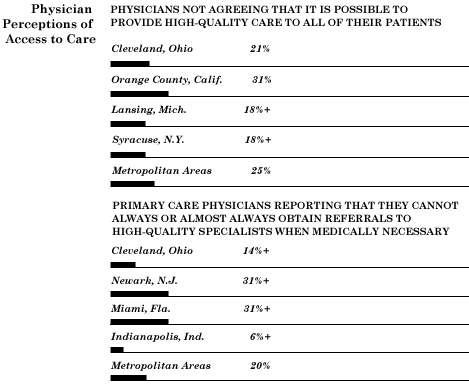
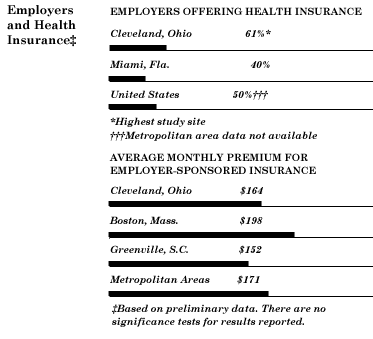
+Site value is significantly different from the mean for metropolitan areas over 200,000
population.
The information in these graphs comes from the Household, Physician and Employer Surveys conducted in 1996 and 1997 as part of HSC’s Community Tracking Study. The margins of error depend on the community and survey question and include +/- 2 percent to +/- 5 percent for the Household Survey, +/-3 percent to +/-9 percent for the Physician Survey and +/-4 percent to +/-8 percent for the Employer Survey.
Background and Observations
